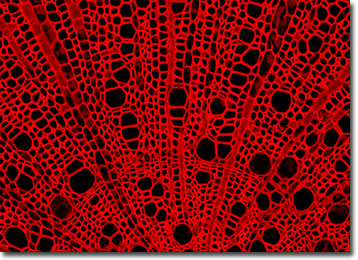Fluorescence Digital Image Gallery
Basswood (Tilia) Root
Sometimes called bee trees, the fragrant flowers of basswoods attract large numbers of bees and other pollinating insects during the warm months of spring and summer. The honey produced by bees that solely feed upon their pollen is lightly colored and has a distinctive strong flavor.

Basswood trees are characterized by tall, straight trunks and a deep wide-spreading root system that makes them less vulnerable to wind than many other species. The American basswood, scientifically described as Tilia Americana, is also renowned for its heavy foliaged crown that features dark green heart-shaped leaves that reveal more lightly colored glistening undersides when rustled by a breeze. The hardwood tree is well suited for growth in the fertile soils of the northeast United States, where it proliferates in great numbers as a favorite ornamental shade tree.
An important commercial species, basswood is widely utilized for items such as furniture, picture frames, kitchen utensils, and caskets. The light, fine textured wood of the tree is also a favorite of hand carvers and basket makers. The creamy colored flowers of basswoods are utilized to make linden tea and were once recommended to be placed in a hot bath to help alleviate one’s cold. Basswoods also formerly held religious significance in some societies including the aboriginal peoples of North America who used to carve ritual masks into the living trees. If the chosen tree survived the process, the mask was believed to possess special powers.
BACK TO THE FLUORESCENCE DIGITAL IMAGE GALLERY
